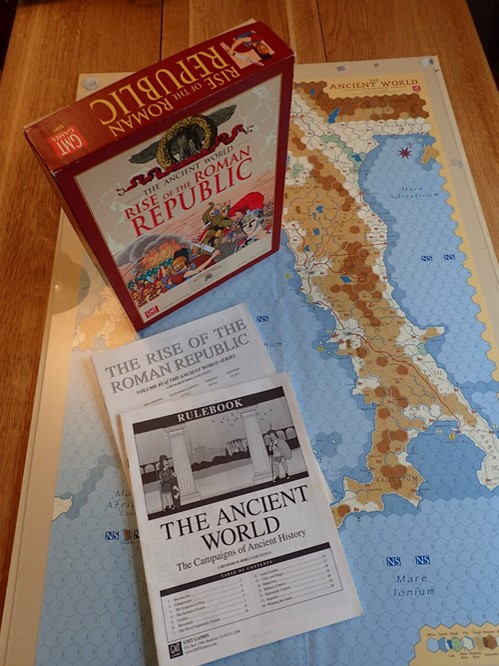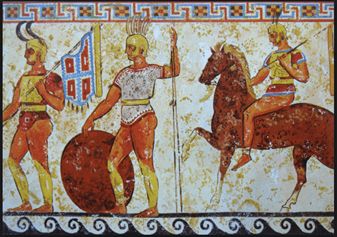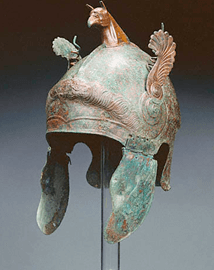The Samnite Wars:
some history and after action reports

from the GMT Games’ Rise of the Roman Republic
Volume 1 of the Ancient World Series,
designed by Richard Berg
 A brief history of Rome’s conquest of central Italy
A brief history of Rome’s conquest of central Italy
The Samnite Wars were a series of long-running conflicts between the fledgling Republic of Rome and a neighbouring hill tribe to the east, the Samnites, for domination of central Italy. At this time, Rome was just one of several powers on the Italian mainland.
The First Samnite War (343-340) was mostly squabbles and skirmishes. By the time of the major conflict, the Second Samnite War (327-304), Rome’s predatory ambition was becoming clear to all the tribes of Italy. At the least provocation, the Roman Republic’s Senate would send out armies to defeat and dominate a tribe and acquire its assets. None of the other tribes – the Samnites, the Apulians, Campanians or Etruscans – appear to have had the determination and discipline that Rome displayed. This, and her pool of manpower, meant that Rome ultimately prevailed.
 But the Second Samnite War started off poorly for Rome, with the disaster at the Caudine Forks in 325 B.C.: two consular armies were trapped in a pass by Samnium’s greatest commander, Gaius Pontius, and were forced to surrender. After that, Rome’s strengths came to the fore, her consular armies marching around central and southern Italy, defeating enemy armies almost every year. The Romans did, however, find it difficult to convince the Samnites to submit even after they had lost a battle, as they would return with an even larger army two or three years later. Finally, after being crushed at Luceria and Aquileona, the Samnites submitted, for a while.
But the Second Samnite War started off poorly for Rome, with the disaster at the Caudine Forks in 325 B.C.: two consular armies were trapped in a pass by Samnium’s greatest commander, Gaius Pontius, and were forced to surrender. After that, Rome’s strengths came to the fore, her consular armies marching around central and southern Italy, defeating enemy armies almost every year. The Romans did, however, find it difficult to convince the Samnites to submit even after they had lost a battle, as they would return with an even larger army two or three years later. Finally, after being crushed at Luceria and Aquileona, the Samnites submitted, for a while.
By 298 B.C., the Samnites were ready to enter the fray with Rome again in the Third Samnite War (298-290), but this time with some help. They formed a loose coalition with the Etruscans, Umbrians, and – to Rome’s horror – the fierce Gauls of northern Italy. Rome reacted with resolution. With one consular army distracting the Etruscans and Umbrians, the major Roman army crushed the Gauls and Samnites at Sentinum, one of the decisive battles in Roman history. After 290 B.C., the Samnites, and the other tribes of central Italy, were submissive, if sometimes unreliable, allies of Rome.
The Samnite War scenario
Rather than take players through some 50 years or so of Roman history, the scenario on the Samnite Wars focuses on a ten year conflict, with each year represented by a game turn. Just for clarity, the scenario opens in 320 B.C., potentially running on to 311 B.C. It starts with the situation and deployment that led to the Caudine Forks.
 Although the Samnites were ultimately doomed, to win the Samnite player does not have to conquer Rome. Instead he needs to avoid losing by striving to maintain the Samnites as a viable, political entity. Moreover, some of the other Italian tribes may revolt and rise up against Rome, further complicating the task of the Roman player. And, if the Gauls enter the fray in support of the Samnites, then a loose coalition really piles the pressure on the fledgling Roman Republic.
Although the Samnites were ultimately doomed, to win the Samnite player does not have to conquer Rome. Instead he needs to avoid losing by striving to maintain the Samnites as a viable, political entity. Moreover, some of the other Italian tribes may revolt and rise up against Rome, further complicating the task of the Roman player. And, if the Gauls enter the fray in support of the Samnites, then a loose coalition really piles the pressure on the fledgling Roman Republic.
The scenario’s specific victory conditions are:
The Roman player wins at the end of a game turn if:
-
he controls all cities in Samnium; and
-
the Alliance Level of all other provinces is either neutral or in favour of the Romans; and
-
there is no active Tribe in revolt on the map.
The Samnite player wins if:
-
He occupies Rome, or
-
The Roman player has not satisfied his victory conditions by the end of the 10th game turn.
Players can by agreement play beyond the scenario’s ten game turns until one side wins – see the scenario notes.
After Action Reports (AARs)
What follows will be a series of AARs, each covering the game narrative – year by year, or turn by turn – as it evolves from the plans and decisions of two opposing players. To avoid burdening readers with game detail and mechanics in the main narrative, endnotes are used to record which game mechanic applied or the outcome of die rolls. So onto the first year of the scenario, 320 B.C….